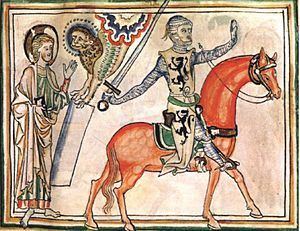Name Guy, of | ||
 | ||
Died March 7, 1305, Compiegne, France Children Robert III, Count of Flanders, John I, Marquis of Namur Parents Margaret II, Countess of Flanders, William II of Dampierre Siblings William II, Count of Flanders Grandchildren John II, Duke of Brabant, Louis I, Count of Nevers | ||
Guy of Dampierre (Dutch: Gwijde van Dampierre) (c. 1226 – 7 March 1305, Compiègne) was the Count of Flanders (1251–1305) and Marquis of Namur (1268–97). He was a prisoner of the French when his Flemings defeated the latter at the Battle of the Golden Spurs in 1302.
Contents

Biography

Guy was the second son of William II of Dampierre and Margaret II of Flanders. The death of his elder brother William in a tournament made him joint Count of Flanders with his mother. (She had made William co-ruler of Flanders 1246 to ensure that it would go to the Dampierre children of her second marriage, rather than the Avesnes children of her first.) Guy and his mother struggled against the Avesnes (led by John I, Count of Hainaut) in the War of the Succession of Flanders and Hainault, but were defeated in 1253 at the Battle of Walcheren, and Guy was taken prisoner. By the mediation of Louis IX of France, he was ransomed in 1256. Some respite was obtained by the death of John of Hainaut in 1257.
In 1270, Margaret confiscated the wares of English merchants in Flanders for non-payment of customs. This led to a devastating trade war with England, which supplied most of the wool for the Flemish weavers. The dispute was ended by a treaty agreed at Montreuil-sur-Mer on 28 July 1274, effectively abolishing customs charged on English merchants in Flanders. Even after her abdication in 1278, Guy often found himself in difficulties with the fractious commoners.
In 1288, complaints over taxes led Philip IV of France to tighten his control over Flanders. Tension built between Guy and the king; in 1294, Guy arranged a marriage between his daughter Philippa and Edward, Prince of Wales. However, Philip imprisoned Guy and two of his sons, forced him to call off the marriage, and imprisoned Philippa in Paris until her death in 1306. Guy was summoned before the king again in 1296, and the principal cities of Flanders were taken under royal protection until Guy paid an indemnity and surrendered his territories, to hold them at the grace of the king.
After these indignities, Guy attempted to revenge himself on Philip by an alliance with Edward I of England in 1297, to which Philip responded by declaring Flanders annexed to the royal domain. The French under Robert II of Artois defeated the Flemings at the Battle of Furnes, and Edward's expedition into Flanders was abortive. He made peace with Philip in 1298 and left Guy to his fate. The French invaded again in 1299 and captured both Guy and his son Robert in January 1300.
The Flemish burghers, however, found direct French rule to be more oppressive than that of the count. After smashing a French army at the Battle of the Golden Spurs in 1302, Guy was briefly released by the French to try to negotiate terms. His subjects, however, refused to compromise; and a new French offensive in 1304 destroyed a Flemish fleet at the Battle of Zierikzee and fought the Flemings to a draw at the Battle of Mons-en-Pévèle. Guy was returned to prison, where he died.
Family
In June 1246 he married Matilda of Béthune (d. 8 November 1264), daughter of Robert VII, Lord of Bethune, and had the following children:
In March 1265 he married Isabelle of Luxembourg (d. September 1298), daughter of Henry V of Luxembourg, and had the following children:
